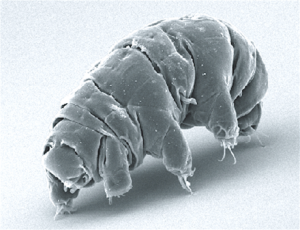Extinction is roaming the world. In truly shocking new science, Australian biologist Corey Bradshaw finds we are closer to the brink than anyone thought. Plus a great new action song from Sweden, and an intimate chat with one of the foremost climate scientists in the world, Dr. Phil Jones from the University of East Anglia.
Listen to or download this Radio Ecoshock show in CD Quality (57 MB) or Lo-Fi (14 MB)
Listen to or download my 26 minute interview with Dr. Corey Bradshaw in CD Quality or Lo-Fi
Listen to or download my 29 minute interview with Dr. Phil D. Jones in CD Quality or Lo-Fi
CO-EXTINCTION: THE BIOLOGICAL THREAT MULTIPLIER – COREY BRADSHAW
We are living in a time of mass extinction of species large and small. How serious is that? What are the rules of extinction? Two scientists, Italian and Australian, investigated. Their study published in Nature, November 2018, contains unpleasant surprises.
Our guest is Dr. Corey Bradshaw. He is the Matthew Flinders Fellow in Global Ecology, at Flinders University in South Australia. Corey has published at least 300 papers, and three books. His latest is “The Effective Scientist: A Handy Guide to a Successful Academic Career”, published by Cambridge University Press in March 2018.
We are discussing his new paper, with Giovanni Strona, “Co-extinctions annihilate planetary life during extreme environmental change“.
The introduction to the paper begins: “Being in the midst of the sixth mass extinction…” This leaves no doubt we are experiencing a mass extinction now, but are we in the middle of it, or just at the start? Do we know where we are in this process?
Within the concept of co-extinction, Bradshaw and co-author Giovanni Strona portray interdependent webs of life that help diverse creatures survive. But interdependence also creates a fragility that can bring the web down. That sounds similar to worries about our human system during globalization. Can interdependence be both a source of strength and fragility?
From the paper: “co-extinctions are often triggered well before the complete loss of an entire species, so that even oscillations in the population size of a species could result in the local disappearance of other species“.
It doesn’t even take extinction of one species to trigger the end of others. Even a sudden drop in one species may remove the food chain for other species, who become extinct. Now think about the 90% decline of large fish in the ocean, or the 75% drop in insects in some places. All that, before extreme climate change kicks in.
To some degree, this paper was stimulated by a paper led by David Sloan of Oxford. Published in 2017, the title is: “The Resilience of Life to Astrophysical Events“. Sloan’s team offered some comfort: sure humans may go extinct, but some creatures are so hardy that even extreme climate change will not kill them off. They give the example of the tiny Tardigrade.

But wait, even the tough tardigrades rely on other biological life for food. Their food supplies may be much less hardy than the tardigrades, and die off. Human food may be much less adaptive to rapid climate change than we are.
Even if we don’t get hit by an asteroid, this paper by Bradshaw and Strona suggests that about 5 degrees Centigrade warming could be the beginning of the biological end, at least of the species we know and can see. That is not because we could not survive it. It is because of “co-extinction”, a factor which the authors find drives extinction at a rate ten times greater than previous estimates.

Dr. Corey Bradshaw, Australia
Here is one explanation of “co-extinction” in scientific language, from the paper:
“In a simplified view, the idea of co-extinction reduces to the obvious conclusion that a consumer cannot survive without its resources. Because resource and consumer interactions in natural systems (e.g., food webs) are organized in various hierarchical levels of complexity (e.g., trophic levels), it follows that the removal of resources could result in the cascading (bottom-up) extinction of several higher-level consumers.”
“That paper shocked me,” Corey tells us. “Now I get bad news every day. The world is in an extinction spiral right now and environmental degradation is happening across the board. And I’m not just talking about climate change. I’m talking about deforestation and pollution and feral species, invasive species and the loss of insects – the list goes on. Climate change is a very strong stressor in a system that’s already highly stressed. But when we did this paper, I had to sit back and go ‘Wow!’ I did not expect it to be this bad.”
There are bloggers and you tubers out there saying five degrees C is not survivable for humans. Why should we believe Corey Bradshaw? I looked into that. For one thing, his more than 300 published papers have gone into many direct studies of details that build into this recent science. That’s all peer-reviewed, as is this paper. We are talking about a well-known Australian biologist. He’s been a Principal Research Fellow at Charles Darwin University, the Sir Hubert Wilkins Chair of Climate Change at the University of Adelaide, Chief Investigator at the distinguished ARC Centre of Excellence for Australian Biodiversity and Heritage, and now the Matthew Flinders Fellow in Global Ecology, at Flinders University in Adelaide.
Bradshaw is not an idle mind Tweeting about developing danger. He is reporting it from a network of scientists and mountains of fact and experience. Maybe we should really pay attention!
I’ve seen institutional and business plans trying to accommodate five or six degrees of warming, because we just have to burn all the fossil fuels. The public does not know we are rapidly approaching a heat ceiling. In the interview, Bradshaw seems to accept two degrees warming already as a given. I could add another half to one degree just from a cleanup of pollution. We continue to accelerate our emissions of greenhouse gases. As the atmosphere loads up, other natural systems are kicking in more greenhouse gases, or losing their ability to store excess carbon (e.g. forests and oceans).
Starting from two degrees C by 2030 (warming over pre-industrial times) – humanity only has two or three degrees more warming before we begin to succumb to a mass extinction that includes our food sources. We are running out of heat space, or heat time. Bradshaw and Strona show we have hopelessly overestimated the ability of life to survive a rapid burst of climate change driven by human actions. If you only listen to one interview this month, or only pass one on to others, this is it.
Once again, listen to or download my 26 minute interview with Dr. Corey Bradshaw in CD Quality or Lo-Fi. And here is a tiny url to work with Twitter or Facebook (the URL leads to this blog): http://tinyurl.com/yy5ky5vz
THREE RULES OF EXTINCTION
Here are three rules of extinction I found in this paper:
Rule 1: during warming, the most ecologically important species go first, not last.
Rule 2: global warming drives more species to extinction faster than global cooling.
Rule 3: during warming, plants tend to go extinct first. That seems counter-intuitive, very different from the way we humans picture a mass extinction starting with the largest animals.
EXTINCTION IN AUSTRALIA
In Australia, the pro-level journal called “The Conversation” just published an article “An end to endings: how to stop more Australian species going extinct“. Corey explains we are losing a lot of creatures from the rare Australian ecosphere.
The authors, which include Ross Garnaut propose ten steps, including:
“1. We should commit to preventing any more extinctions.
2. We should craft an intergenerational social contract.
3. We should highlight our respect for, and obligation to, nature in our constitution... ”
Coincidentally, Corey just published another paper in which he explains the “Dingo” are not “wild dogs” but an indigenous Australian species. As such, they need protection. Ranchers, who think of Dingoes as the enemy, are allowed to poison or trap them. They don’t want to hear Bradshaw’s new science, and he expects to get some threats. It’s been a big story down under.
A NEW CLIMATE SONG
On the show I play the new song “We Don’t Have Time” written by Ingemar Beattone Aberg, CJ Palmer and Adam Baptiste, with a little Gret Thunberg in the track. On Earth Day, this April 22nd, you can visit the new social network “for saving the climate and truly making a difference.” Get a sneak preview at wedonthavetime.org. Next up: Phil Jones.
TIME WITH A GREAT SCIENTIST: PHIL D. JONES
How do we know Planet Earth is really warming? Partly because Dr. Phil D. Jones tracks temperature records from all over the world. Dr. Jones published hundreds of papers, which are highly cited in climate science. For 20 years in the UK, he directed the Climatic Research Unit at the University of East Anglia. Now he is Professorial Fellow in the School of Environmental Sciences at the University. Jones was awarded his Doctorate in Hydrology in 1977, and only three years later began his life’s work of collecting temperature records from around the world. He was influenced by Hubert Lamb, the first Director of the Climatic Research Unit at East Anglia.

Dr. Phil D. Jones (credit: The Telegraph, UK)
Phil Jones HELPED DEVELOP AND PUBLISHED A STANDARD TEMPERATURE RECORD.
At first it was land-based, and it later became a synthesis of land and marine records. This alone would be a historic creation by any scientist. Phil is very modest, pointing to the thousands of other scientists and record-keepers who actually gather the data. But they send their information to Phil Jones, who has patiently sorted things out, cross-checking, searching for greater and greater accuracy. For me, Jones is like Charles David Keeling, the man who established the Mauna Loa Observatory record of carbon dioxide – but this time for the record of global temperature. Most of climate science depends on temperature records where Jones has played a significant role.
In his 2001 edited book “History and Climate: Memories of the Future?” we find that up to the mid-1970s’ scientists thought humans live in a fixed climate, at least within our time frame. Even that recently, science had to shake off the Medieval view of a never-ending stable cycle with minor variations. Phil also helped connect the previously separate fields of climate and history.
THE MEDIEVAL WARM PERIOD?
Jones published on the temperature records for the last 1,000 years. In particular, he investigated “the concepts embodied in the terms ‘Medieval Warm Period’ and ‘Little Ice Age'”. He explains what those periods really mean in our interview. Finding “Both periods are barely recognizable in the few Southern Hemisphere reconstructions available,” and not that extreme in other records, he concludes “The ‘Medieval Warm period’ and ‘little Ice Age’ are most clearly recognized as European phenomena.”
We also discuss an earlier “Dark Ages Cold Period” starting around the year 570 CE, after Rome had been conquered by Germanic tribes. Was the primitive state of governance and culture on Europe during those so-called “Dark Ages” also a reflection of a climatic period? Probably not, as this earlier Dark Ages Cold Period is thought to result from volcanic eruptions. The cold from volcanoes only lasts a few years, the length of time their dust can stay in the atmosphere, shielding Earth from the sun.
For more on this see “Dark Ages Cold Period: A literature review and directions for future research” by Samuli Helama, Phil D Jones, Keith R Briffa, published February 1, 2017, in the journal “The Holocene”.
Also from “History and Climate” we find this passage: “The most intriguing result of this work is that, while western Europe has experienced long-term warming in annual series, this has only occurred during the winter half of the year. Summers were milder in the 1750-1850 period than in much of the twentieth century…”
Now almost 30 years on, Phil Jones is still at it, collecting and collating temperature records, from the Mediterranean to China.
In the Abstract of the paper, “Global land surface air temperature dynamics since 1880“, led by Chinese researchers with Phil as co-author, we read… “…warming exhibited different spatial patterns in different periods. In the early 20th century (1923–1950), warming occurred mainly in the mid-high latitudes of the Northern Hemisphere, whereas in the most recent decades (1977–2014), warming was more spatially extensive across the global land surface.”
Just to show the global and wide-ranging nature of his research, in 2017 Jones also co-authored a paper on wildfires in Borneo.
REMEMBERING FINE SCIENTISTS WE LOST
Sadly, this year Phil had to help write a Memoriam to his colleague Keith R. Briffa. Phil tells us about the man, and why his work matters. Phil and Keith shared the same office for 25 years. Briffa specialized in recreating climatic records from tree rings, a field known as “dendrochronology”. His work is highly cited, becoming a building block for a lot of later science.
We also recently lost the pioneer American scientist Wallace Smith Broecker, the man credited with coining the term “global warming”. Broecker also established a great base of knowledge about the ocean conveyor belt. In his last message to scientists, Wally Broecker called for more research into geoengineering to shade the planet. I ask Phil if we approaching such a dire need.
All this returns to a theme I have raised with several guests. Many of us will not live to see the dangerous inheritance we leave to coming generations. In a strange way, I am disappointed. I may not live to see climate science fully vindicated, or society acting to save itself. Does that bother you?
Phil Jones retired as Professor at the University of East Anglia, and as the Director of the Climatic Research Unit. Now he is Professorial Fellow in the School of Environmental Sciences at the University, and still publishing scientific papers. For example, Phil Jones is co-author in a continuing series or papers which attempt to “rescue” temperature records and meteorological observations from the southern Mediterranean region, from 1877 on, to more adjustments to the long-term temperature series in China. (Both published 2018)
As we spoke, there were incredible temperatures in the UK this winter. As the Guardian says:
“This week’s record winter heat in the UK was so far above normal trends that scientists have been forced to reconsider their statistical models, with one expert calling the temperature jump “incredible”.”
HELLO!
A special hello to dozens of listeners from Saint-Hyacinthe, Canada and Wallingford, Connecticut, tuning in through the Radio Ecoshock Soundcloud page this week. If that’s you, drop me a line. The address is: radio@ecoshock.org You can also listen to or download each and every new Radio Ecoshock show, going back years if you want, absolutely free posted every Wednesday on this show web site, ecoshock.org.
The 100 non-profit radio stations broadcasting Radio Ecoshock weekly do not pay me for the program. I provide it free, and free to thousands of listeners every week by downloads and podcast. I do it to raise awareness of our ecological danger, to inspire change, and to interest the public in science. There is no Foundation giving me a grant, and as you can see, I don’t allow advertising on this web site or in the show. That means… I can only keep going as long as I get financial support from you the listener. Please consider a monthly donation, or a one-time gift. Find out how here.
I’m Alex. Thank you for listening, learning, and loving this amazing planet. Join me again next week, for more Radio Ecoshock.
Great web site! Thanks for this.
Pingback: The week in climate and nuclear news- Australia and beyond | Nuclear Australia
Thank you, Alex. Quality site, broadcast & work you are doing here.